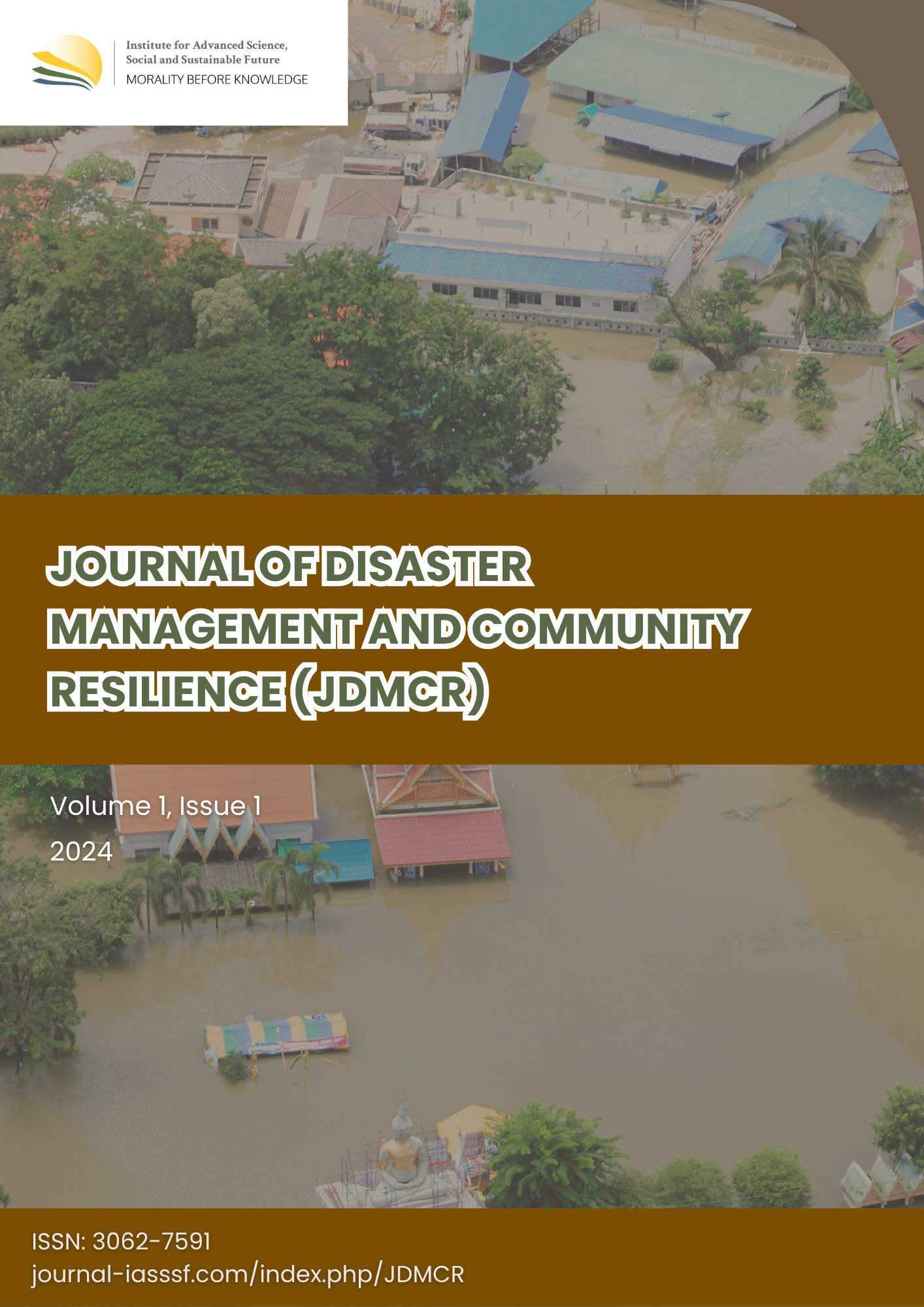Bencana natural hazard-triggered technological accidents pada kota industri rawan bencana
DOI:
https://doi.org/10.61511/jdmcr.v1i1.883Keywords:
natech, disaster risk management, disaster mitigation, risk management strategies, systematic literature reviewAbstract
Background: Natural hazard-triggered technological accidents (natech), formed from the intersection of natural disasters causing technological accidents, have garnered attention regarding disaster management and risk mitigation. A profound understanding of natech risk management strategies and practices becomes highly significant. This research explores and synthesizes findings from existing literature, with a specific focus on two case studies: one from Japan and another from Indonesia, to identify best practices, challenges, and recommendations for enhancing natech risk management strategies. Methods: Through the systematic literature review (SLR) method, this research identifies, evaluates, and integrates findings from various literature sources, including journal articles, government reports, and natech disaster-related documentation. Finding: This analysis yields valuable insights into key factors influencing the effectiveness of natech disaster response and mitigation, such as effective planning and coordination, community involvement, and the application of current technology and innovation. The research results indicate that effective risk management strategies require an integrated approach that combines technical, organizational, and social aspects. Additionally, the research also highlights the importance of adaptation and flexibility in risk management strategies and practices to address the complexity and uncertainty associated with natech disasters. Conclusion: Based on the literature synthesis, this research also presents concrete recommendations for enhancing policies, practices, and further research in the field of natech risk management.
References
Akbar, M., Bhat, M. S., & Khan, A. A. (2023). Multi-hazard susceptibility mapping for disaster risk reduction in Kargil-Ladakh Region of Trans-Himalayan India. Environmental Earth Sciences, 82(2). https://doi.org/10.1007/s12665-022-10729-7.
Alexander, D. (2021). Cascading disasters: Multiple risk reduction and resilience. In Handbook of Disaster Risk Reduction for Resilience: New Frameworks for Building Resilience to Disasters. https://doi.org/10.1007/978-3-030-61278-8_8.
Araki, Y., Hokugo, A., Pinheiro, A. T. K., Ohtsu, N., & Cruz, A. M. (2021). Explosion at an aluminum factory caused by the July 2018 Japan floods: Investigation of damages and evacuation activities. Journal of Loss Prevention in the Process Industries, 69. https://doi.org/10.1016/j.jlp.2020.104352.
Binder, S. B., Ritchie, L. A., Bender, R., Thiel, A., Baker, C. K., Badillo, E., Goodfellow, S., Kulp, B., & Weir, P. (2020). Limbo: the unintended consequences of home buyout programmes on peripheral communities. Environmental Hazards, 19(5), 488–507. https://doi.org/10.1080/17477891.2020.1714537.
Boell, S. K., & Cecez-Kecmanovic, D. (2015). On being ‘Systematic’ in Literature Reviews in IS. Journal of Information Technology, 30(2), 161-173. https://doi.org/10.1057/jit.2014.26.
Cruz, A. M. & Krausmann, E., 2009. Hazardous-materials releases from offshore oil and gas facilities and emergency response following Hurricanes Katrina and Rita. Journal of Loss Prevention in the Process Industries, 22(1), 59-65. https://doi.org/10.1016/j.jlp.2008.08.007.
Gill, D. A., & Ritchie, L. A. (2023). Energy development and sociocultural inequality among First Nation Peoples. In Handbook on Inequality and the Environment.
Iwata, M., Kamura, Y., Honoki, H., Kobayashi, K., Ishiki, M., Yagi, K., Fukushima, Y., Takano, A., Kato, H., Murakami, S., Higuchi, K., Kobashi, C., Fukuda, K., Koshimizu, Y., & Tobe, K. (2020). Family history of diabetes in both parents is strongly associated with impaired residual b -cell function in Japanese type 2 diabetes patients. Journal of Diabetes Investigation, 11(3), 564-572. https://doi.org/10.1111/jdi.13176.
Kitchenham, B., Brereton, O. P., Budgen, D., Turner, M., Bailey, J., & Linkman, S. (2009). Systematic literature reviews in software engineering – A systematic literature review. Information and Software Technology, 51(1), 7–15. https://doi.org/10.1016/j.infsof.2008.09.009.
Krausmann, E. & Necci, A. (2021). Thinking the unthinkable: A perspective on Natech risks and Black Swans. Safety Science, 139. https://doi.org/10.1016/j.ssci.2021.105255.
Lestari, F., Jibiki, Y., Pelupessy, D., Imamura, F., Zulys, A., Kadir, A., & Paramitasari, D. (2021). Exploratory study for strengthening education sectors for responding to complexities due to NATECH (natural-hazard triggered technological disasters) disasters. IOP Conference Series: Earth and Environmental Science, 630(1). https://doi.org/10.1088/1755-1315/630/1/012022.
Lestari, F., Setyowati, D. L., Muzanni, A., Kadir, A., Zainal, I., Adolf Liku, J. E., Zulfikar, A. K., Sari, I. P., Mulya, W., Yuliana, L., Pradipta, E., & Cruz, A. M. (2023). Industrial and Environmental Disaster Risk Assessment for Hazardous Materials in Balikpapan City, East Kalimantan, Indonesia. Sustainability (Switzerland), 15(12). https://doi.org/10.3390/su15129430.
Leveson, N. G. (2011). Applying systems thinking to analyze and learn from events. Safety Science, 49(1), 55–64. https://doi.org/10.1016/j.ssci.2009.12.021.
Nakhal Akel, A. J., Hovstad, J. S., Ruth, M. S., Parmeggiani, S., Patriarca, R., & Paltrinieri, N. (2022). A Machine Learning Approach to Analyze Natural Hazards Accidents Scenarios. Chemical Engineering Transactions, 91, 397–402. https://doi.org/10.3303/CET2291067.
Nishino, T., & Takagi, Y. (2020). Numerical analysis of tsunami-triggered oil spill fires from petrochemical industrial complexes in Osaka Bay, Japan, for thermal radiation hazard assessment. International Journal of Disaster Risk Reduction, 42. https://doi.org/10.1016/j.ijdrr.2019.101352.
Ohtsu, N., Hokugo, A., Cruz, A. M., Sato, Y., Araki, Y., & Park, H. (2023). Evacuation of vulnerable people during a Natech: a case study of a flood and factory explosion in Japan. International Journal of Disaster Resilience in the Built Environment, 14(1), 53–67. https://doi.org/10.1108/IJDRBE-04-2021-0043.
Olivar, O. J. R., Mayorga, S. Z., Giraldo, F. M., Sánchez-Silva, M., Pinelli, J.-P., & Salzano, E. (2020). The effects of extreme winds on atmospheric storage tanks. Reliability Engineering and System Safety, 195. https://doi.org/10.1016/j.ress.2019.106686.
Proctor, C. R., Lee, J., Yu, D., Shah, A. D., & Whelton, A. J. (2020). Wildfire caused widespread drinking water distribution network contamination. AWWA Water Science, 2(4). https://doi.org/10.1002/aws2.1183.
Silva, K., Janta, P., & Chollacoop, N. (2022). Points of consideration on climate adaptation of solar power plants in thailand: How climate change affects site selection, construction and operation. Energies, 15(1). https://doi.org/10.3390/en15010171.
Suarez-Paba, M. C., & Cruz, A. M. (2022). A paradigm shift in Natech risk management: Development of a rating system framework for evaluating the performance of industry. Journal of Loss Prevention in the Process Industries, 74. https://doi.org/10.1016/j.jlp.2021.104615.
Takabatake, T., Shibayama, T., Esteban, M., Achiari, H., Nurisman, N., Gelfi, M., … Kyaw, T. O. (2019). Field survey and evacuation behaviour during the 2018 Sunda Strait tsunami. Coastal Engineering Journal, 61(4), 423–443. https://doi.org/10.1080/21664250.2019.1647963.
Downloads
Published
Issue
Section
Citation Check
License
Copyright (c) 2024 Andro Ramada

This work is licensed under a Creative Commons Attribution 4.0 International License.














